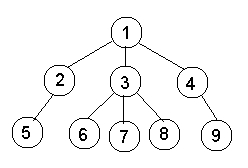LCA in a tree using Binary Lifting Technique
Given a binary tree, the task is to find the Lowest Common Ancestor of the given two nodes in the tree. Let G be a tree then LCA of two nodes u and v is defined as the node w in the tree which is an ancestor of both u and v and is farthest from the root node.If one node is the ancestor of another one than that particular node is the LCA of those two nodes.
Example:
Input:

Output: The LCA of 6 and 9 is 1. The LCA of 5 and 9 is 1. The LCA of 6 and 8 is 3. The LCA of 6 and 1 is 1.
class Solution {
Integer[][] DP;
int logN;
Map<Integer, Integer> map;// Map of root -> Depth level
public void findLCA(TreeNode root, int N, int[][] queries) {
logN = (int) (Math.ceil(Math.log(N) / Math.log(2))) + 1;
DP = new Integer[N][logN];
map = new HashMap<>();
DFS(root, null, 1);
for (int[] query : queries)
System.out.println(LCA(query[0], query[1]));
}
public void DFS(TreeNode root, TreeNode parent, int lvl) {
if (root == null)
return;
if (parent != null)
DP[root.val][0] = parent.val;
for (int i = 1; DP[root.val][i - 1] != null; i++) {
int halfDistNode = DP[root.val][i - 1];
DP[root.val][i] = DP[halfDistNode][i - 1];
}
map.put(root.val, lvl);
DFS(root.left, root, lvl + 1);
DFS(root.right, root, lvl + 1);
}
public int LCA(int P, int Q) {
// We want P to be lower in tree
if (lev[P] < lev[Q]) {
int temp = P;
P = Q;
Q = temp;
}
// Finding the ansector of P, at the level of Q
// Starting from the biggest jump and see if it is under range
for (int i = logN; i >= 0; i--) {
// Math.pow is slow
if ((map.get(P) - 1 << i) >= map.get(Q))
P = DP[P][i];
}
if (P == Q)
return P;
// Finding the children nodes of LCA
// Start with the biggest jump, and as soon as we find the biggest jump
// that results in a node, that is not a common ancestor, we will continue jumps
// from updates positions.
for (int i = log; i >= 0; i--) {
if (DP[P][i] != DP[Q][i]) {
P = DP[P][i];
Q = DP[Q][i];
}
}
// Returning the first ancestor of above found nodes
// As this will be the common ancestor
return DP[P][0];
}
}Last updated